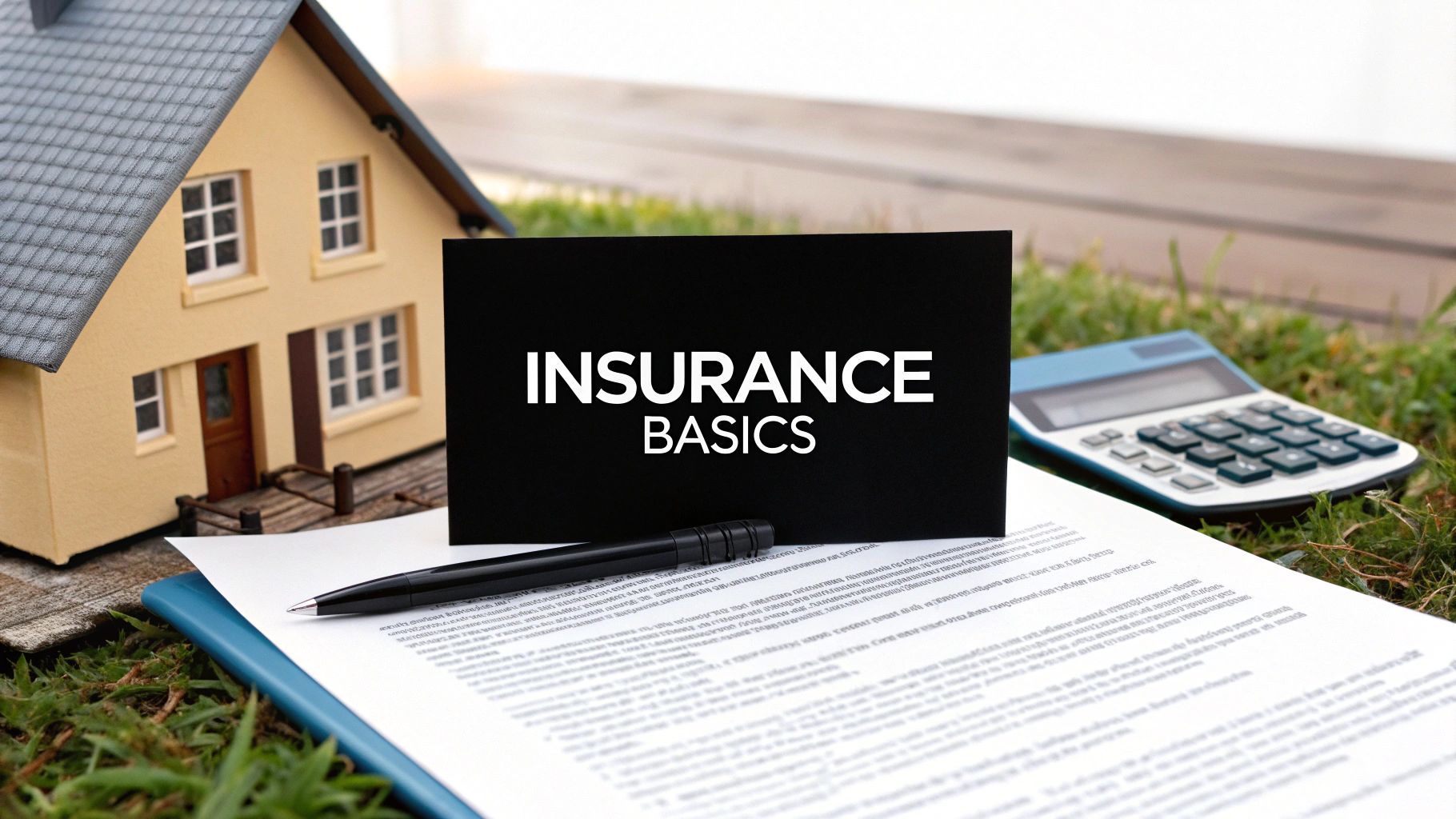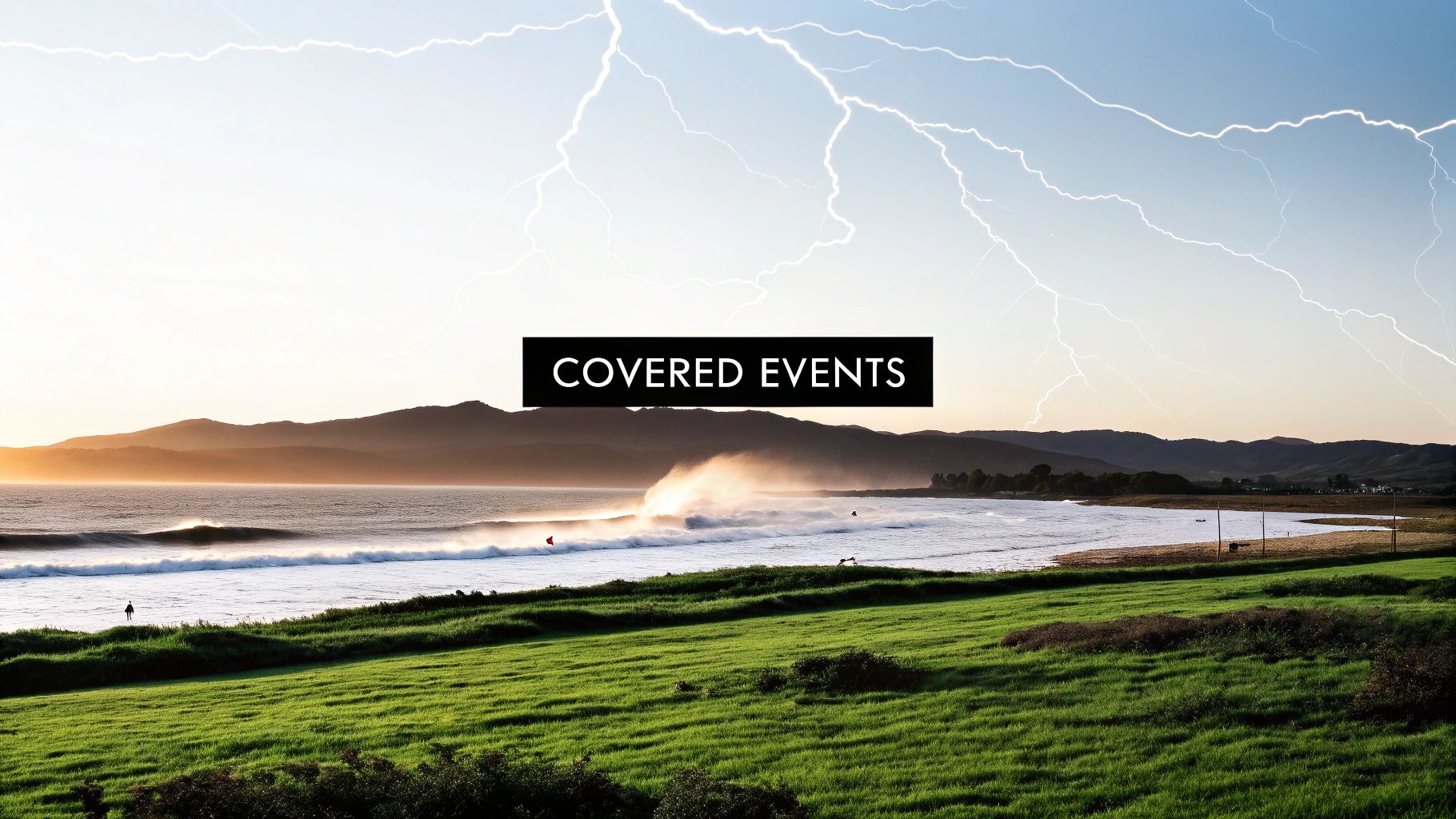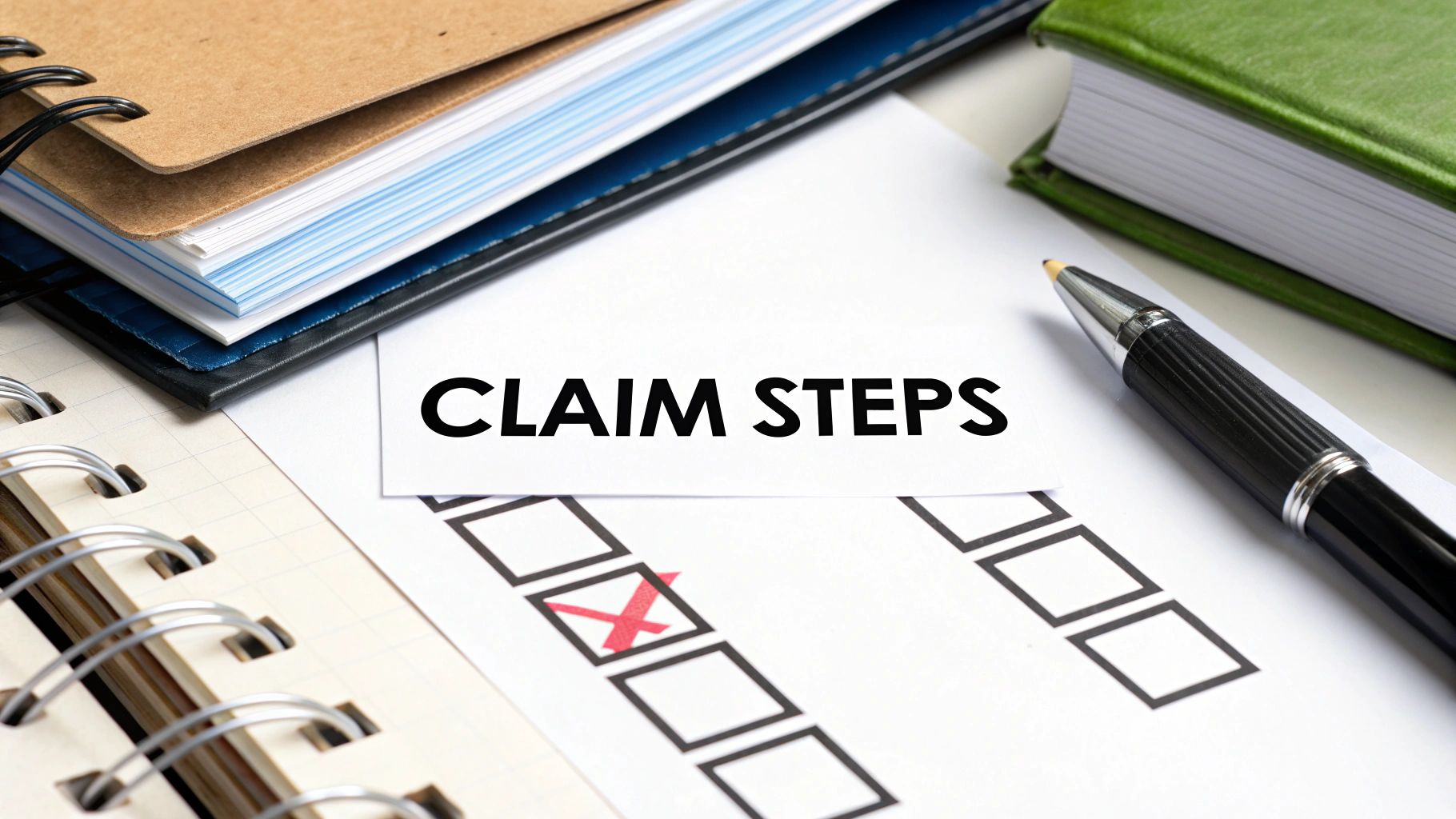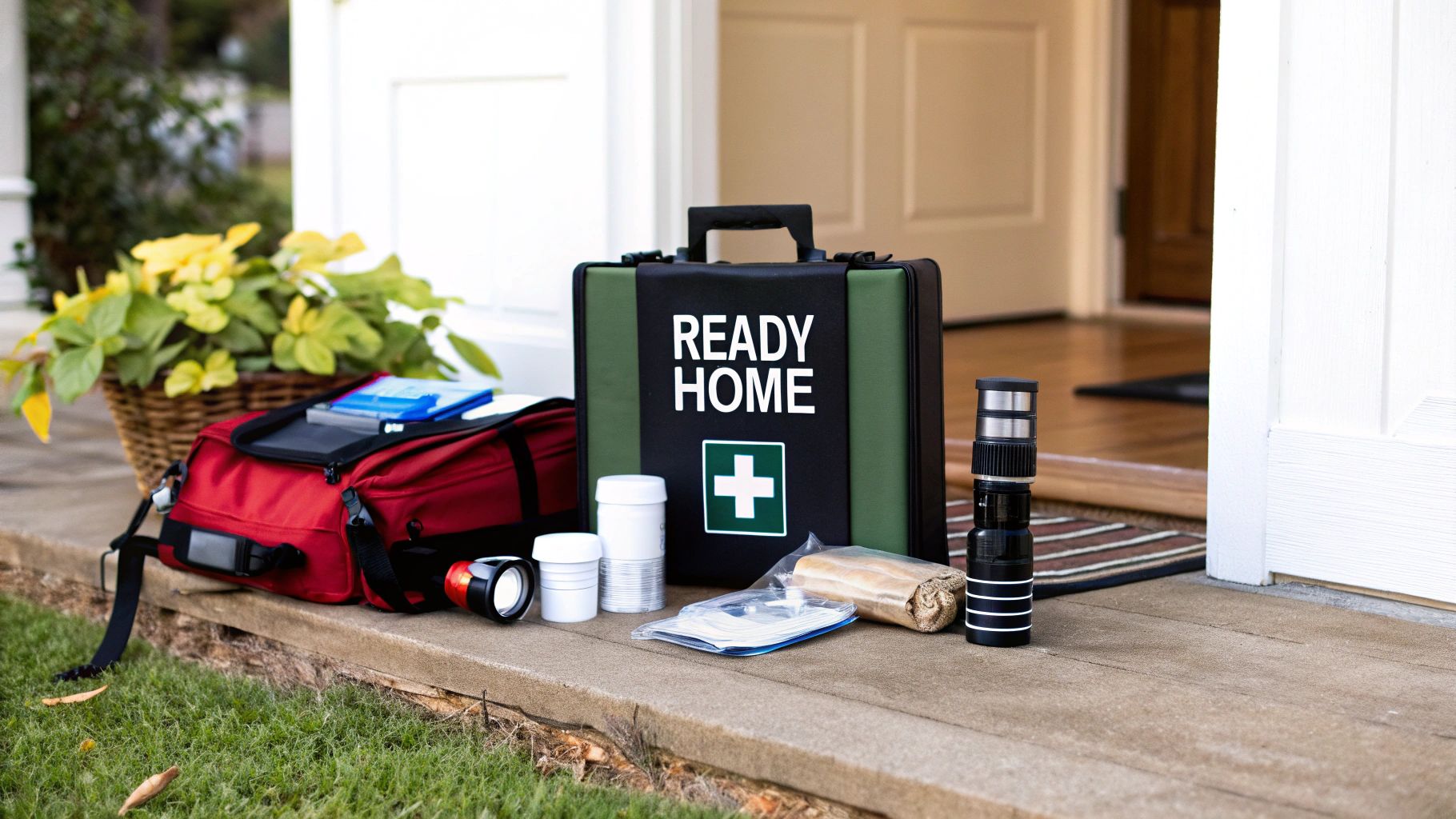Decoding Natural Disaster Coverage in Standard Policies

Understanding insurance coverage for natural disasters is vital for financial security. Many homeowners mistakenly believe their standard policies cover all such events. This isn't always true. This section clarifies what's typically covered and what often requires separate policies, empowering you to make informed insurance decisions.
Common Misconceptions About Natural Disaster Coverage
One misconception revolves around the phrase "acts of God." Some believe it's a universal exclusion, but modern policies specifically list covered and excluded perils. Another misunderstanding involves assuming identical policies offer the same protection everywhere. Insurers assess location-specific risks, impacting coverage and premiums. For example, windstorm damage might be standard in Florida, while earthquake coverage in California might require a separate policy. For further information, check out this helpful resource: Natural Disasters and Home Insurance: What You Need to Know to Stay Protected.
What's Typically Covered in Standard Policies
Standard homeowners insurance usually covers damage caused by:
- Fire and Lightning: This includes wildfires, unless specifically excluded due to location.
- Windstorms and Hail: Damage from wind, hail, and airborne debris is generally covered, though hurricane deductibles might apply in coastal regions.
- Explosions: Coverage typically extends to explosions from events like gas leaks.
- Riots and Civil Commotion: Damage resulting from such events is often included.
The importance of natural disaster coverage has grown due to rising global insured losses. In 2021, these losses reached $130 billion, exceeding the 21st-century average. This increase correlates with the increasing frequency and intensity of natural disasters, often exacerbated by climate change. You can find more detailed statistics from the Insurance Information Institute here. This trend highlights the significant financial implications for homeowners and insurers alike.
What's Usually Excluded and Requires Separate Coverage
While standard policies offer a baseline of protection, some perils often necessitate separate coverage:
- Floods: Flood insurance is typically purchased separately through the National Flood Insurance Program (NFIP) or private insurers.
- Earthquakes: Given the potential for widespread damage, earthquake coverage is usually a separate policy or an endorsement to an existing policy.
- Landslides and Mudflows: These are usually excluded and require specialized coverage.
- Sinkholes: Sinkhole coverage can be complicated, often requiring a specific endorsement or separate policy.
Understanding these exclusions is vital to avoid being underinsured. Careful planning and securing appropriate additional coverage offer essential financial protection in the face of unexpected natural disasters.
The Coverage Matrix: Which Disasters Are Protected and Why

Understanding the nuances of insurance policies can be challenging, especially when it comes to natural disasters. This section clarifies how different natural disasters are handled by insurance companies, outlining what is covered, what isn't, and the reasons behind these distinctions.
Fire, Wind, and Hail: Standard Coverage Considerations
Standard homeowners insurance policies generally cover fire damage, often including damage from wildfires. Wind and hail damage are also typically included. However, homeowners in hurricane-prone areas should be aware of hurricane deductibles. These deductibles are usually a percentage of the home's insured value.
For example, a 2% hurricane deductible on a $300,000 home would be $6,000. This means the homeowner pays the first $6,000 in repairs before the insurance coverage begins. It's a significant amount that homeowners in these areas need to factor into their financial planning.
Flood Insurance: Why It's Separate
Flood insurance isn't typically included in standard homeowners policies, even though flood damage is a common natural disaster claim. This is because flood risk varies significantly from one property to the next. Insurers assess this risk individually.
Flood insurance is usually managed through the National Flood Insurance Program (NFIP) or private insurers. This separation allows for more accurate risk assessment and pricing, and it keeps standard policy premiums more stable for those outside of high-risk flood zones.
Earthquakes and Other Ground Movement: Specialized Protection
Much like floods, earthquakes require specialized coverage. Earthquake insurance is typically a separate policy or an endorsement added to an existing homeowners policy. The potentially catastrophic financial impact of widespread earthquake damage necessitates this separate approach.
This allows insurers to manage and price earthquake risk appropriately. Other types of ground movement, such as landslides and mudflows, often require specialized coverage as well, highlighting the importance of understanding your region's specific risks.
To help you understand what different policy types cover, let's take a look at the following table:
Natural Disaster Coverage by Policy Type
This table provides a clear overview of which natural disasters are covered by different insurance policy types, helping readers quickly identify potential coverage gaps in their current insurance portfolio.
| Disaster Type | Standard Homeowners Policy | Flood Insurance | Earthquake Insurance | Special Considerations |
|---|---|---|---|---|
| Fire | Yes (including wildfires, with some location-based exclusions) | No | No | Review policy for specific exclusions |
| Wind | Yes (including tornadoes, generally) | No | No | Hurricane deductibles may apply in certain areas |
| Hail | Yes | No | No | |
| Flood | No | Yes | No | Separate policy required |
| Earthquake | No | No | Yes | Separate policy or endorsement required |
| Landslide/Mudflow | Typically No | Sometimes (depending on the cause and policy) | Potentially (if caused by earthquake) | Often requires specialized coverage |
| Hurricane | Yes (subject to hurricane deductible) | No (wind damage covered by homeowners, flooding by flood insurance) | No | Separate windstorm and flood policies may be needed |
As you can see, having a comprehensive understanding of your insurance needs based on your geographical location is crucial. Relying solely on a standard homeowners policy might leave you exposed to significant financial risk in the event of certain natural disasters.
Tornadoes vs. Windstorms: A Surprising Difference
Most standard homeowners policies cover wind damage, including damage caused by tornadoes. However, some policies may differentiate between damage caused by straight-line winds and rotating winds (like those in a tornado). While this distinction is less common, it's crucial to review your policy details with your insurance agent. This ensures you understand precisely what is covered and can address any potential gaps.
Wildfire Protection: State-Specific Variations
Wildfire protection varies considerably by state. In some states, it's included as standard coverage in homeowners policies. In others, wildfire risk is assessed more rigorously, potentially leading to separate coverage or higher premiums.
California, for example, has stricter regulations regarding wildfire insurance due to the state's elevated wildfire risk. Understanding your state's specific insurance regulations and wildfire risk levels is essential for making informed decisions about your coverage. This knowledge can protect you from the devastating financial consequences of a wildfire.
The Price of Protection: Understanding Rising Disaster Premiums

Natural disaster insurance premiums are a growing concern for many homeowners. Why are costs escalating in some areas while holding steady in others? It comes down to how insurers assess and price risk. Let's explore the factors driving these premium increases and how they affect your coverage.
Decoding Insurance Risk Algorithms
Insurance companies use complex algorithms to determine premiums. These algorithms weigh various factors, including historical data, geographic location, property type, and the likelihood of specific natural disasters. For example, homes in floodplains face higher flood insurance premiums. Areas with a history of wildfires see increased costs for wildfire coverage. This targeted approach means higher-risk locations carry higher premiums for relevant protection.
This leads to significant regional differences in premium increases. To illustrate this, let's look at a sample data table showcasing average annual premium increases across different regions and disaster types.
To provide a clearer picture of these trends, the table below presents statistical data demonstrating how insurance premiums have increased over the past decade for different types of natural disaster coverage across various regions of the United States.
| Region | Flood Insurance | Earthquake Insurance | Hurricane Coverage | Wildfire Coverage | 5-Year % Increase |
|---|---|---|---|---|---|
| California | 12% | 15% | 8% | 25% | 15% |
| Florida | 18% | 6% | 22% | 9% | 16.25% |
| Texas | 15% | 8% | 19% | 12% | 13.5% |
| Louisiana | 20% | 7% | 25% | 10% | 18% |
| New York | 10% | 12% | 15% | 7% | 11% |
As the table reveals, regions with higher exposure to specific disasters experience correspondingly higher premium increases for coverage related to those events. For instance, California, with its heightened wildfire risk, sees a significant increase in wildfire coverage premiums, while Florida experiences higher increases for hurricane coverage.
Catastrophe Modeling and Your Premium
Catastrophe modeling plays a significant role in premium structures. Insurers use these models to simulate the impact of different disasters, estimating potential losses and setting premiums accordingly. As these models become more sophisticated, premiums may adjust to reflect the evolving understanding of disaster risk.
The financial burden of natural disasters on insurance companies has been particularly high in recent years. In 2024, global insured losses from natural catastrophes reached $154 billion, about 27% above the 10-year average. This increase underscores the escalating costs of providing disaster coverage. Property Casualty 360 provides more detail on these industry statistics.
The insurance protection gap (the difference between insured and total economic losses) also remains significant. 2024 saw total economic damages exceeding $350 billion, indicating many losses are uninsured. This gap highlights the need for broader insurance policies. These models also influence the shift from traditional percentage-based deductibles toward complex risk-sharing models, changing how financial exposure is defined.
Navigating High-Risk Insurance Markets
Insurance availability and affordability in high-risk areas are increasingly challenging. Coverage can be prohibitively expensive or even unavailable. This is especially true for homeowners insurance, often excluding perils like flood and earthquake coverage.
What can homeowners do? Several strategies can help. Explore government-backed insurance programs, raise deductibles to lower premiums, or consult an insurance broker for optimal coverage. Mitigation efforts, such as reinforcing your home against wind or elevating your property, can also reduce risk and potentially lower premiums. These actions can make a substantial difference in protecting your home and finances.
When Disaster Strikes: The Evolving Landscape of Claims

Filing an insurance claim after a natural disaster can be a complicated and overwhelming experience, distinct from a typical property claim. This section examines the critical aspects of natural disaster claims, providing perspectives from both policyholders and insurance professionals. We'll also explore how technology and preparation can contribute to a smoother process. For more information on what your homeowner's insurance covers, read this helpful article: Don't get caught unprepared: What your homeowners insurance policy really covers.
How Technology Is Transforming Disaster Response
Technology is changing the way insurance companies manage disaster claims. Satellite imagery and drone technology are increasingly utilized for swift and efficient damage assessments, often reaching areas inaccessible by traditional methods. This accelerates the initial assessment, leading to quicker response times and potentially faster claim payouts.
Furthermore, mobile claims centers are being deployed to disaster-stricken areas. These centers provide on-site support and streamline the claims process for affected individuals, offering vital assistance during a challenging period.
The Importance of Documentation and Timing
Thorough documentation of your belongings before a disaster is paramount. A detailed home inventory, complete with photos and videos, can greatly simplify the claims process. This inventory acts as evidence of ownership and value, easing the burden of recalling possessions after a traumatic event.
The timing of your claim also plays a significant role. Reporting the damage promptly is crucial for a timely response from your insurance provider. This also helps prevent further damage and preserves vital evidence.
Navigating Claim Denials: Common Reasons and Solutions
Understanding why claims are denied can help you avoid setbacks. Lack of proper documentation, inadequate coverage, or policy exclusions are frequent reasons for denial. Familiarizing yourself with your policy’s terms and conditions is essential.
In the first quarter of 2025 alone, insured losses from global natural disasters exceeded $53 billion. This figure drastically surpasses the 21st-century average of $17 billion for the same period. The Los Angeles wildfires accounted for a significant portion of this total, reaching $38 billion in insured losses. You can find more detailed statistics on insured losses from natural disasters here. These statistics underscore the need for comprehensive insurance coverage and effective claims management. With at least six events in the US exceeding $1 billion in insured losses in the first quarter alone, 2025 is projected to be another expensive year.
Learning from Success: Case Studies in Disaster Recovery
Examining successful claims from past major disasters offers invaluable insights. For instance, some claimants have maximized their recovery by meticulously documenting all expenses related to temporary housing, property repairs, and lost income.
Others have found success by collaborating with public adjusters who advocate on their behalf. These cases demonstrate the importance of being proactive and well-informed throughout the entire claims process.
Beyond Private Insurance: Government Programs That Fill Gaps
Private insurance plays a vital role in protecting against natural disasters. However, it doesn't always provide comprehensive coverage for every scenario. This is where government programs become essential, stepping in to bridge the gaps and offer crucial support, particularly in high-risk areas where private insurers may limit their offerings.
The National Flood Insurance Program (NFIP)
The National Flood Insurance Program (NFIP) is a prime example of government intervention in disaster insurance. Administered by the Federal Emergency Management Agency (FEMA), the NFIP provides flood insurance to homeowners, renters, and businesses in participating communities. Over the years, the program has seen significant changes, impacting both premiums and coverage options. These revisions aim to more accurately reflect current flood risks and ensure the program's long-term sustainability.
State-Specific Initiatives
In addition to federal programs, many states offer their own disaster insurance solutions tailored to their specific needs. The California Earthquake Authority (CEA) is one such example. It's a publicly managed, privately funded organization providing earthquake insurance to Californians. Similarly, Florida's Citizens Property Insurance Corporation offers windstorm coverage in high-risk coastal areas where private insurance is often limited or unavailable. These programs demonstrate how states are proactively addressing their unique disaster vulnerabilities.
Both the CEA and Citizens have specific eligibility requirements and coverage limitations. Understanding these details is crucial for homeowners considering these options. For further information on preparing your home insurance for natural disasters, check out this helpful article: Is Your Home Insurance Policy Ready for a Natural Disaster? Tips for Being Prepared.
Emerging Trends: Hybrid and Parametric Insurance
The field of disaster insurance is constantly evolving, with new approaches regularly emerging. Hybrid public-private partnerships are becoming increasingly common, combining the backing of government support with the efficiency of the private sector. These partnerships often aim to expand coverage options and improve affordability. Finding reliable repair services after a disaster is also crucial. Ellingson Roofing offers expert storm damage repair and can be a valuable resource in such situations.
Parametric insurance represents another innovation in the industry. This type of insurance pays out based on pre-defined event triggers, such as wind speed or earthquake magnitude, rather than assessed damage. This streamlined process can expedite claims payouts, providing rapid financial assistance after a disaster. These innovative alternatives are gaining importance as traditional coverage options become less readily available or more expensive.
Understanding the Limitations
Government programs offer valuable safety nets, but they also have limitations. Coverage limits may not fully compensate for all losses, and premiums can be substantial, particularly in high-risk areas. It's essential to understand these limitations when making informed decisions about supplementing coverage with private insurance or exploring other risk mitigation strategies. Combining government programs with private options creates a more robust and comprehensive protection strategy.
Building Your Personal Disaster Insurance Strategy
Creating effective disaster insurance requires a strategic approach, going beyond simply purchasing a policy. This involves carefully assessing your specific risks, thoroughly understanding your existing coverage, and making well-informed decisions. The goal is to ensure you have adequate protection without unnecessary costs.
Assessing Your Risks: Location, Property, and Climate
The first step in developing a strong disaster insurance strategy is understanding your unique risks. Your geographic location is key. Are you located in a flood zone? Is your region prone to earthquakes or wildfires? Knowing these risks helps determine your coverage priorities.
Property characteristics are also crucial. A home built on a hillside faces different risks than a home on level ground. Your home's age and construction materials impact its vulnerability to damage. Also, consider changing climate patterns. Is your area experiencing increasingly severe weather? These factors, combined with your location and property type, provide a complete view of your risk profile.
Auditing Your Current Coverage: Finding Gaps and Redundancies
After identifying your risks, review your existing insurance policies. Does your homeowners insurance cover wind damage? Given your location, do you need flood insurance? This coverage audit can reveal potential gaps in your protection. It also helps identify any redundancies, meaning you might be over-insured. You could be paying for coverage you already have under a different policy.
Creating a Home Inventory: Documentation Is Key
After a disaster, recalling all your possessions can be challenging. A home inventory provides essential documentation for insurance claims. Use digital tools, photos, and videos to catalog your belongings. Keep this inventory updated and stored securely, ideally in a cloud-based service or an off-site location. This detailed record streamlines the claims process and ensures proper compensation for your losses.
Balancing Coverage and Budget: Smart Choices for Protection
Balancing coverage with budget is a common concern. Prioritize essential coverage based on your risk assessment. Consider raising your deductible to lower your premium, but make sure you can afford the deductible if a disaster occurs. Compare quotes from different insurance providers to find the best combination of cost and coverage. This careful approach provides adequate protection without overspending.
Determining Coverage Limits and Deductibles: Finding the Right Fit
Choosing appropriate coverage limits and deductibles is vital. Coverage limits determine the maximum payout for a covered loss. Deductibles are the amount you pay out-of-pocket before your insurance coverage begins. These amounts should be based on your property’s value, risk assessment, and financial situation. Underestimating coverage limits can leave you financially exposed, while very low deductibles can lead to higher premiums.
By following these steps, you can build a personalized disaster insurance strategy that provides the necessary protection within your budget. Review your policy annually and update your home inventory regularly. This proactive approach keeps your coverage aligned with your changing needs and circumstances.
Comments are closed.